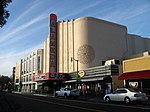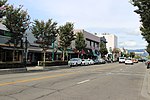Park Street Bridge

The Park Street Bridge is a double-leaf bascule drawbridge spanning 372 feet of the Oakland Estuary in the San Francisco Bay Area. It links the cities of Oakland and Alameda. In a year, the bridge is opened approximately 1700 times and carries approximately 40,000 vehicles per work day. It was built when the Oakland Estuary was trenched, converting Alameda from a peninsula to an island. The Park Street bridge is one of the four bridges that allow access to Alameda. It is considered the best route for bicycles to cross to Alameda as the small narrow walkway in the Posey Tube is difficult to navigate if there is another pedestrian or bicyclist also using it.According to the Historic Bridges.org, The design of this fixed trunnion bascule bridge is strikingly similar to the earliest fixed trunnion bascule bridges built in Chicago in the first decade of the 20th Century including external rack (visible at the ends of the trusses) and through truss design (with no overhead bracing at the center of the bridge), however this California example dates to 1935.
Excerpt from the Wikipedia article Park Street Bridge (License: CC BY-SA 3.0, Authors, Images).Park Street Bridge
Park Street Bridge, Oakland
Geographical coordinates (GPS) Address External links Nearby Places Show on map
Geographical coordinates (GPS)
| Latitude | Longitude |
|---|---|
| N 37.771688888889 ° | E -122.23656944444 ° |
Address
Park Street Bridge
Park Street Bridge
94601 Oakland
California, United States
Open on Google Maps







